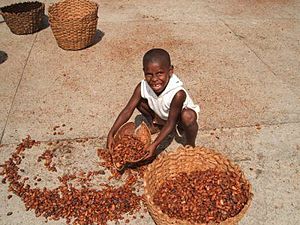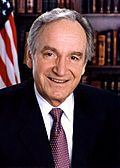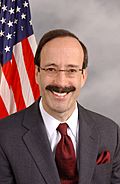Harkin–Engel Protocol facts for kids
The Harkin–Engel Protocol, sometimes referred to as the Cocoa Protocol, is an international agreement aimed at ending the worst forms of child labor (according to the International Labour Organization's Convention 182) and forced labor (according to ILO Convention 29) in the production of cocoa, the main ingredient in chocolate. The protocol was negotiated by U.S. Senator Tom Harkin and U.S. Representative Eliot Engel in response to a documentary and multiple articles in 2000 and 2001 reporting widespread child slavery in the production of cocoa. The protocol was signed in September 2001. Joint Statements in 2001, 2005 and 2008 and a Joint Declaration in 2010 extended the commitment to address the problem.
The industry's pledge to reduce child labor in Ivory Coast and Ghana by 70%, as per the Protocol, had not been met by late 2015; the deadline was again extended, to 2020.
Protocol and 2001 Joint Statement
The Harkin–Engel Protocol is a voluntary public-private agreement to eliminate the worst forms of child labor (defined according to the International Labour Organization (ILO)'s Convention 182) in the growth and processing of cocoa in Côte d’Ivoire and Ghana. The protocol was a voluntary agreement that partnered governments, the global cocoa industry, cocoa producers, cocoa laborers, non-governmenal organizations. The agreement laid out a series of date-specific actions, including the development of voluntary standards of public certification. The Protocol did not commit the industry to ending all child labor in cocoa production, only the worst forms of it. The parties agreed to a six-article plan:
- Public statement of the need for and terms of an action plan—The cocoa industry acknowledged the problem of forced child labor and will commit "significant resources" to address the problem.
- Formation of multi-sectoral advisory groups—By 1 October 2001, an advisory group will be formed to research labor practices. By 1 December 2001, industry will form an advisory group and formulate appropriate remedies to address the worst forms of child labor.
- Signed joint statement on child labor to be witnessed at the ILO—By 1 December 2001, a statement must be made recognizing the need to end the worst forms of child labor and identify developmental alternatives for the children removed from labor.
- Memorandum of cooperation—By 1 May 2002, Establish a joint action program of research, information exchange, and action to enforce standards to eliminate the worst forms of child labor. Establish a monitor and compliance with the standards.
- Establish a joint foundation—By 1 July 2002, industry will form a foundation to oversee efforts to eliminate the worst forms of child labor. It will perform field projects and be a clearinghouse on best practices.
- Building toward credible standards—By 1 July 2005, the industry will develop and implement industry-wide standards of public certification that cocoa has been grown without any of the worst forms of child labor.
A 2001 Joint Statement extended the protocol to also identify and eliminate forced labor (defined according to ILO Convention 29) in the production of cocoa.
The protocol laid out a non-binding agreement for the cocoa industry to regulate itself without any legal implications, but Engel threatened to reintroduce legislation if the deadlines were not met. This agreement was one of the first times an American industry was subjected to self-regulation and one of the first times self-regulation was used to address an international human rights issue.
See also
 In Spanish: Protocolo Harkin-Engel para niños
In Spanish: Protocolo Harkin-Engel para niños




